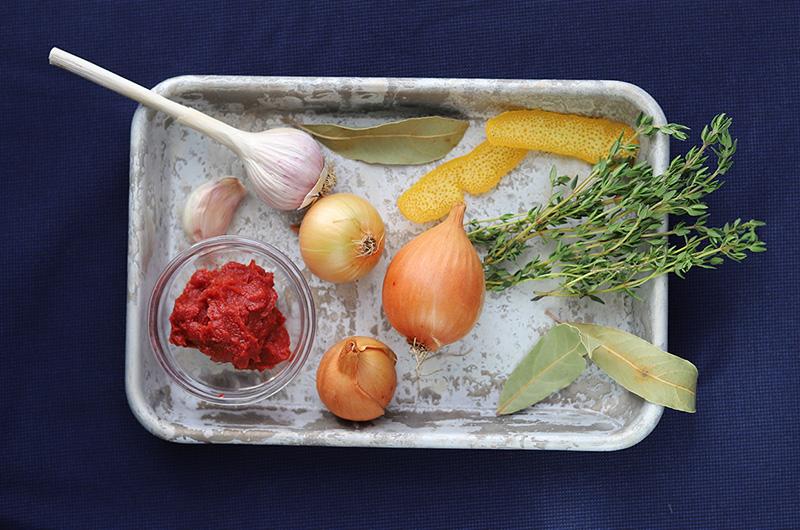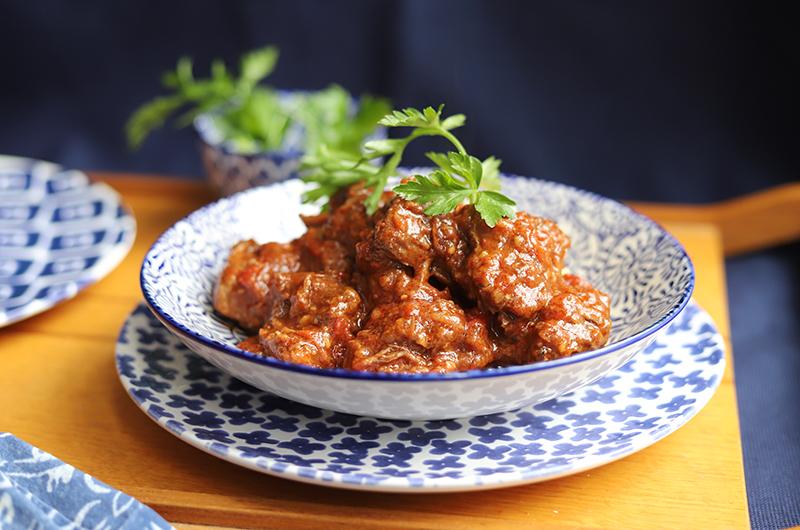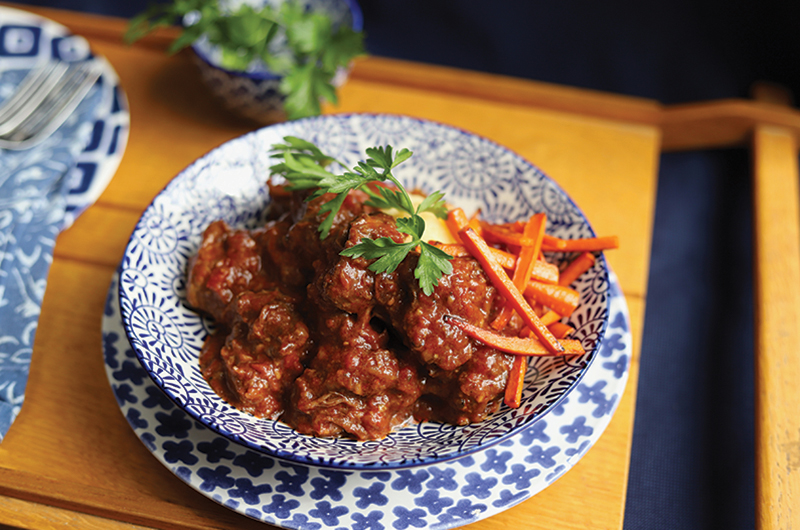
Lately my ninety-four-year-old father has tired of cooking. He had a good run, so you can hardly blame him. Instead, my sister has been cooking up a storm, making big batches of soups, stews, and casseroles that she can portion and freeze for him. She’s his own personal Meals on Wheels. Every so often she consults me about the meal plan, and I send her new ideas and recipes. At the top of my list: a rich and hearty slow-cooked beef stew.
Here on the Island, I’ve been leaning on this delicious stew for so many reasons. I just brought some to friends who were packing up to move, having been jolted out of their long-time rental on short notice. Argh! I also froze enough so that I could have an instant dinner to defrost when my thirty-something-year-old stepson comes over to eat with us on a weeknight. I stashed an extra portion for my husband to heat up on a night I’m at a meeting or my book club. (We’re not exactly swimming in takeout options in West Tisbury, especially during the off-season.)
This winter I’ll bring the beef stew to potlucks – and hopefully bring the potluck to my own table as well.
Navigating the off-season on the Vineyard is infinitely better with a great stew recipe up your sleeve. It’s not just the satisfaction we get as cooks from the alchemy we produce in the kitchen. It’s knowing we can help friends and family too, for whom the winters here aren’t easy. We all know folks who are in the same boat as my dad – or my sister. And for so many of us, a warming, hearty meal is one of the things that makes the long, dark days bearable.
So why this particular stew? Two reasons. First, I think this recipe combines the best of two cuisines. It’s a wonderful marriage of a French daube (with plenty of red wine) and an Italian meat ragù (with plenty of tomatoes). I attended French culinary school and then immediately went to work in an Italian restaurant, so I hope I’ve brought the best of both together in my Rich Beef Stew recipe on the following page. I don’t like thin or watery beef stews, so this one is thick and rich, hence the name.
Second, I think – with so many good cooks on the Island – that we’re ready to up our beef stew game.
Recently, I went leafing through my Martha’s Vineyard cookbooks, and I have to say I didn’t find a good beef stew recipe. As much as I love the many renditions of The Martha’s Vineyard Cookbook (Harper & Row, first edition 1971) by the late Louise Tate King and Jean Stewart Wexler, the one entry for beef stew – Joseph Chase Allen’s Dry Beef Stew – does not read like something I could easily reproduce. Nor, with all due respect to Allen, who was a beloved writer for the Vineyard Gazette in the mid-1900s and an Islander with deep roots, would I want to! One of his tips: “Incidentally, it doesn’t matter a whoop what part of the animal it comes from; neck to tail, it can be used.”
Now, I’m all for head-to-tail cooking, but I can tell you that a richly marbled piece of chuck roast, cut into pieces, is going to be much more flavorful and meltingly tender after braising (a gentler approach than boiling) than a lean cut from the round or the flank. In fact, that’s my first tip for you: buy a chuck roast – or thick chuck steaks – and cut into two-inch pieces. My grandmother insisted on chuck! Cronig’s Market always has chuck this time of year, and Bob Pacheco at Reliable Market said that if he doesn’t have it out, he can cut it for you or get it in. Stop & Shop usually has chuck too. I don’t see it as often in the meat cases of our local farms.
For building flavor and winding up with the right texture, you’ll want to do a few things. Always brown your meat pieces first. This is a messy (though fun) operation because not only does the caramelization increase the flavor of the meat, but it also leaves a layer of browned bits on the bottom of the pan. You will use wine to deglaze these browned bits, which will then dissolve in your cooking liquid, adding lots of flavor.

As I alluded to above, I use a combination of red wine, canned tomatoes, and a little broth to cook the beef.
For the wine, be sure it is something you would drink – never use inferior wine in cooking.
For the canned tomatoes, I use whole peeled tomatoes, as they are always better quality than crushed tomatoes. I use a hand-held potato masher to break them apart. I’m happy to say that Morning Glory Farm now carries Bianco DiNapoli brand canned whole peeled tomatoes. I had read that Wirecutter, a New York Times property, had voted this brand the best canned tomato option for four years running, so I finally tried them. And now I know why – the tomatoes are of a very high quality, and they are enrobed by a thick, rich tomato purée. Definitely worth seeking out.
For the broth, you have some flexibility. Canned beef broth can be strong-tasting, so if you use it, cut it with water. Low-sodium chicken broth is fine. I’m also a big fan of making a quick dried mushroom broth. You can add the dried mushrooms into the stew after steeping if you like. Be careful about boxed veggie broths, which can taste overwhelmingly of celery or onion. Taste before you use, and don’t be afraid to cut with water. Homemade veggie broth is fine. My braising liquid is also flavored by bacon, onions, garlic, tomato paste, thyme, bay leaves, and orange peel.
Lastly, I don’t add big chunks of vegetables to my stew, as they will get mushy when cooked in the stew liquid. Instead, I do a quick sauté of carrots right before serving and offer both those and steamed peas as add-ons to anyone who wants them. You could also garnish with quick-roasted root vegetables (see the recipe Quick-Roasted Root Medley). If I have potato lovers around, I serve the stew over mashed potatoes. If not, I serve it over rice, pasta, or polenta.
Best of all, this beef stew freezes well, so when you make it, be sure to portion off a few cups to have at the ready for emergencies or to take to friends. We all need a little help getting through the winter!







